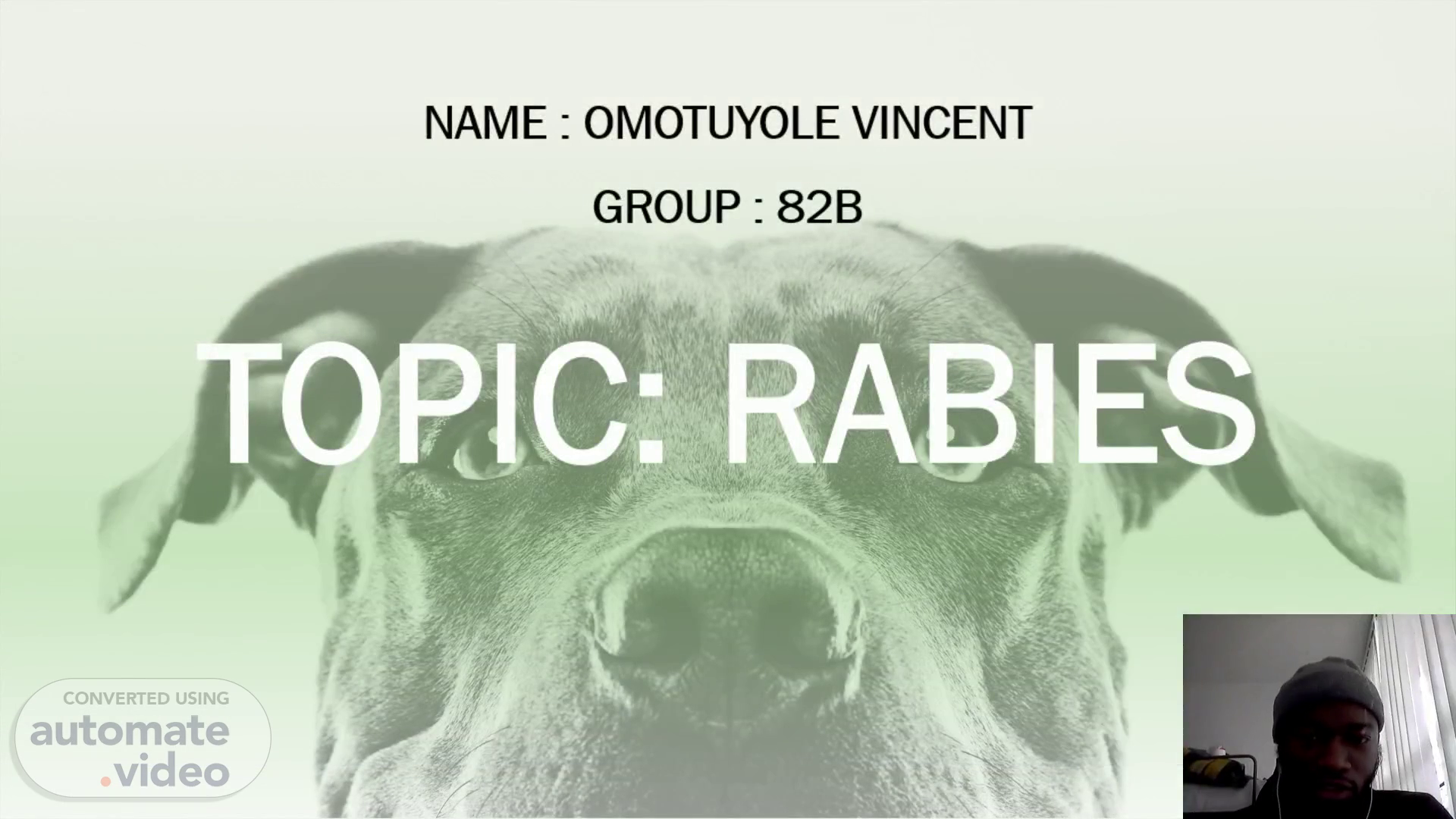
PowerPoint Presentation
Scene 1 (0s)
A dog looking at the camera. NAME : Omotuyole Vincent Group : 82b Topic: RABIES.
Scene 2 (10s)
A dog looking at the camera. RABIES: Rabies is a neurotropic virus contracted from the bite of an infected animal. The virus enters the patient's skin from the saliva of the animal and migrates along the peripheral nerves to the central nervous system ( CNS )..
Scene 3 (25s)
A dog looking at the camera. EPIDEMIOLOGY: Found in animal reservoirs in most countries throughout the world Considerable divide between developed and developing countries in terms of human death due to rabies Incidence worldwide: Up to 70,000 people die of rabies each year. Incidence in the US: Three people on average die of rabies each year..
Scene 4 (58s)
A dog looking at the camera. ETIOLOGY: Pathogen Rabies is caused by several different members of the Rhabdoviridae family. Rhabdoviruses are rod or bullet shaped Genus: Lyssavirus ssRNA Transmission Most common animal reservoir worldwide: dogs Most common animal reservoirs in the US: bats , raccoons, skunks, and foxes Spread through saliva of rabid animal after bite injury Via aerosols (e.g., bat caves); rare.
Scene 5 (1m 47s)
A dog looking at the camera. PATHOPHYSIOLOGY: Rabies virus binds the Ach - receptor of peripheral nerves in the bite wound → migrates retrogradely along the axonal microtubules (using motor protein dynein ) → enters the CNS → infects the brain Diencephalon , hippocampus , and brainstem are involved first Causes acute, progressive, and fatal encephalitis → encephalitic rabies In < 20% of cases, causes ascending flaccid paralysis → paralytic rabies.
Scene 6 (3m 3s)
A dog looking at the camera. Clinical features: General: Incubation period: 4–12 weeks average Prodromal symptoms Flu-like symptoms (e.g., fever , malaise) Locally: pain , paraesthesia , and pruritus near the bite site Encephalitic rabies (most common type) Hydrophobia : Rabies patients experience involuntary, painful pharyngeal muscle spasms when trying to drink; later on in the disease, the sight of water alone may provoke nausea or vomiting. CNS symptoms Anxiety , agitation , and combativeness alternating with calm periods Confusion and hallucinations Photophobia Fasciculations Seizures ↑ Muscle tone and reflexes with nuchal rigidity Autonomic symptoms (e.g., hypersalivation, hyperhidrosis ) Coma and death within days to weeks of the development of neurological symptoms.
Scene 7 (4m 13s)
A dog looking at the camera. Clinical features: Paralytic rabies (< 20% of cases) Flaccid paralysis , gradually ascending and spreading from bite wound [4] Paraplegia and loss of sphincter tone Respiratory failure and death The pathognomonic feature of rabies is hydrophobia ( Hydrophobia An irrational fear of swallowing liquids, often associated with painful dysphagia) due to pharyngeal muscle spasm. This may present along with agitation , strange behavior , mental status changes, and possibly foaming at the mouth..
Scene 8 (4m 33s)
A dog looking at the camera. Diagnostics: Antemortem diagnosis Several tests using multiple specimens must be performed to diagnose rabies because individual tests have limited sensitivity. Evidence of the virus can only be obtained after disease onset. Four specimens are required for testing : serum, saliva, CSF , and skin [9] Laboratory tests RT-PCR to detect rabies RNA Cell culture to isolate the virus Fluorescent antibody testing (FAT) to detect viral antigen in a smear or frozen section of a biopsy Antibody testing (indirect fluorescent antibody test) Serum antibodies detected in individuals who are not immunized and did not receive postexposure prophylactic immunoglobulins indicate the diagnosis Rising serum antibody levels over several days in immunized patients are suggestive of rabies infection Antibodies in the CSF regardless of the immunization history are indicative of rabies infection Additional tests CSF testing: findings characteristic of encephalitis.
Scene 9 (5m 43s)
A dog looking at the camera. Post-mortem diagnosis: Post-mortem brain tissue autopsy Immunofluorescent staining of viral antigen in infected CNS tissue Histopathological findings: Negri bodies (eosinophilic cytoplasmic inclusion bodies typically found in the cerebellum and hippocampus ).
Scene 10 (6m 4s)
A dog looking at the camera. Rabies risk assessment Administer PEP(post exposur e prophylaxis) Bite by a known wild reservoir for rabies (e.g., bats, raccoons, skunks, foxes), if the animal is not available for testing or if the test comes back positive Bite by a domestic carnivore (e.g., dog) not available for observation or displaying symptoms of rabies Observe/test animal and possibly administer PEP Attack by an unvaccinated domestic carnivore without symptoms of rabies (e.g., dog) → observe animal for a 10-day period Animal remains normal: PEP is not necessary Animal starts to display symptoms of rabies Euthanize and study brain samples of the animal Administer PEP to patient PEP is stopped if test results of the animal are negative PEP is not required Bite by a vaccinated domestic carnivore Bite by an indoor domestic herbivore.
Scene 11 (7m 2s)
A dog looking at the camera. Rabies post-exposure prophylaxis : Cleaning and debridement , as with all bite wounds Tetanus shot and antibiotic prophylaxis may be indicated Nonimmunized patient: postexposure prophylaxis (passive-active immunization ) Rabies immunoglobulin is given into the site of the wound by injection ( passive immunization ) PLUS inactivated rabies vaccine is given IM on days 0, 3, 7, and 14 ( active immunization ) Prior immunization [12] Even patients who have been vaccinated against rabies should be treated after exposure! Rabies vaccine IM on days 0 and 3. No immunoglobulin Check antibody titres on day 14 Symptomatic encephalitic or paralytic rabies Palliative treatment ( pain management and sedation).
Scene 12 (8m 6s)
A dog looking at the camera. Vaccination (preexposure prophylaxis) Vaccine : inactivated (killed) vaccine Indications People with frequent occupational contact with potentially rabid animals Travelers to regions in which rabies is widespread (especially if PEP may not be readily available) Obligation to report Rabies is a nationally notifiable disease according to the CDC..
Scene 13 (8m 16s)
A dog looking at the camera. THE END:. Pin on animals.